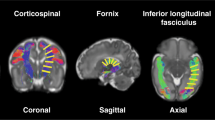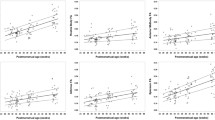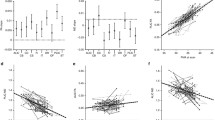Abstract
Introduction
Preterm children with thinning of the corpus callosum (CC) frequently achieve poor neurodevelopmental outcomes despite the absence of a definite brain lesion. Here, the authors compared the microstructural characteristics of the CC in preterm and full-term children using diffusion tensor imaging (DTI).
Methods
Twenty-two preterm children with no definite focal lesion but with thinning of the CC by conventional magnetic resonance imaging and 23 age-matched full-term children were investigated by DTI. CCs were subdivided into genu, rostral body, body, isthmus, and splenium, and voxel counts (VC), fractional anisotropies (FA), and apparent diffusion coefficients (ADC) were measured in each subdivision. Eleven preterm and 11 age-matched full-term subjects underwent follow-up scanning and interval changes in these parameters for each subdivision were compared.
Results
VC and FA were significantly lower in the preterm group than in the full-term group, particularly in the isthmus. Furthermore, incremental changes in VC and FA were significantly smaller in the preterm group. Differences in maturation between the two groups were more pronounced with age in all subdivisions except the splenium. At all ages, noticeable FA differences between the two groups were observed in the isthmus. For white matter tracts, the preterm group displayed lower FA and fiber number, higher ADC values than the term group.
Conclusions
The present study shows that thinning of the CC is correlated with lower FA value and that it is more pronounced in preterm children. In addition, the isthmus was found to be the most vulnerable subdivision in preterm children.


Similar content being viewed by others
References
Hofer S, Frahm J (2006) Topography of the human corpus callosum revisited-comprehensive fiber tractography using diffusion tensor magnetic resonance imaging. NeuroImage 32:989–994
Fryer SL, Frank LR, Spadoni AD, Theilmann RJ, Nagel BJ, Schweinsburg AD, Tapert SF (2008) Microstructural integrity of the corpus callosum linked with neuropsychological performance in adolescents. Brain Cogn 67:225–233
Kalaycioglu C, Nalcaci E, Schmiedt-Fehr C, Basar-Eroglu C (2009) Corpus callosum has different channels for transmission of spatial frequency information. Brain Res 1296:85–93
Stewart AL, Rifkin L, Amess PN, Kirkbride V, Townsend JP, Miller DH, Lewis SW, Kingsley DP, Moseley IF, Foster O, Murray RM (1999) Brain structure and neurocognitive and behavioural function in adolescents who were born very preterm. Lancet 353:1653–1657
Kontis D, Catani M, Cuddy M, Walshe M, Nosarti C, Jones D, Wyatt J, Rifkin L, Murray R, Allin M (2009) Diffusion tensor MRI of the corpus callosum and cognitive function in adults born preterm. Neuroreport 20:424–428
Park HJ, Kim JJ, Lee SK, Seok JH, Chun J, Kim DI, Lee JD (2008) Corpus callosal connection mapping using cortical gray matter parcellation and DT-MRI. Hum Brain Mapp 29:503–516
Witelson SF (1989) Hand and sex differences in the isthmus and genu of the human corpus callosum. Brain 112:799–835
Lamantia AS, Rakic P (1990) Cytological and quantitative characteristics of four cerebral commissures in the rhesus monkey. J Comp Neurol 291:520–537
Di Virgilio G, Clarke S, Pizzolato G, Schaffner T (1999) Cortical regions contributing to the anterior commissure in man. Exp Brain Res 124:1–7
Aboitiz F (1992) Brain connections: interhemispheric fiber systems and anatomical brain asymmetries in humans. Biol Res 25:51–61
Raybaud C (2010) The corpus callosum, the other great forebrain commissures, and the septum pellucidum: anatomy, development, and malformation. Neuroradiology 52:447–477
Kier EL, Truwit CL (1996) The normal and abnormal genu of the corpus callosum: an evolutionary, embryologic, anatomic, and MR analysis. AJNR Am J Neuroradiol 17:1631–1641
Keshavan MS, Diwadkar VA, DeBellis M, Dick E, Kotwal R, Rosenberg DR, Sweeney JA, Minshew N, Pettegrew JW (2002) Development of the corpus callosum in childhood, adolescence and early adulthood. Life Sci 70:1909–1922
Rakic P, Yakovlev PI (1968) Development of the corpus callosum and cavum septi in man. J Comp Neurol 132:45–72
Van der Knaap MS, Valk J (1995) Magnetic resonance of myelination and myelin disorders, third edition. Springer, Berlin
Volpe JJ (1981) Neurology of the newborn. Major Probl Clin Pediatr 22:1–648
Hart AR, Whitby EW, Griffiths PD, Smith MF (2008) Magnetic resonance imaging and developmental outcome following preterm birth: review of current evidence. Dev Med Child Neurol 50:655–663
Yeatman JD, Ben-Shachar M, Bammer R, Feldman HM (2009) Using diffusion tensor imaging and fiber tracking to characterize diffuse perinatal white matter injury: a case report. J Child Neurol 24:795–800
Anderson NG, Laurent I, Woodward LJ, Inder TE (2006) Detection of impaired growth of the corpus callosum in premature infants. Pediatrics 118:951–960
Peterson BS, Anderson AW, Ehrenkranz R, Staib LH, Tageldin M, Colson E, Gore JC, Duncan CC, Makuch R, Ment LR (2003) Regional brain volumes and their later neurodevelopmental correlates in term and preterm infants. Pediatrics 111:939–948
Arzoumanian Y, Mirmiran M, Barnes PD, Woolley K, Ariagno RL, Moseley ME, Fleisher BE, Atlas SW (2003) Diffusion tensor brain imaging findings at term-equivalent age may predict neurologic abnormalities in low birth weight preterm infants. AJNR Am J Neuroradiol 24:1646–1653
Inder TE, Huppi PS, Warfield S, Kikinis R, Zientara GP, Barnes PD, Jolesz F, Volpe JJ (1999) Periventricular white matter injury in the premature infant is followed by reduced cerebral cortical gray matter volume at term. Ann Neurol 46:755–760
Peterson BS, Vohr B, Staib LH, Cannistraci CJ, Dolberg A, Schneider KC, Katz KH, Westerveld M, Sparrow S, Anderson AW, Duncan CC, Makuch RW, Gore JC, Ment LR (2000) Regional brain volume abnormalities and long-term cognitive outcome in preterm infants. JAMA 284:1939–1947
Nagy Z, Westerberg H, Skare S, Andersson JL, Lilja A, Flodmark O, Fernell E, Holmberg K, Bohm B, Forssberg H, Lagercrantz H, Klingberg T (2003) Preterm children have disturbances of white matter at 11 years of age as shown by diffusion tensor imaging. Pediatr Res 54:672–679
Nosarti C, Rushe TM, Woodruff PW, Stewart AL, Rifkin L, Murray RM (2004) Corpus callosum size and very preterm birth: relationship to neuropsychological outcome. Brain 127:2080–2089
Narberhaus A, Segarra D, Caldu X, Gimenez M, Junque C, Pueyo R, Botet F (2007) Gestational age at preterm birth in relation to corpus callosum and general cognitive outcome in adolescents. J Child Neurol 22:761–765
Latal B (2009) Prediction of neurodevelopmental outcome after preterm birth. Pediatr Neurol 40:413–419
Qiu M, Li Q, Liu G, Xie B, Wang J (2010) Voxel-based analysis of white matter during adolescence and young adulthood. Brain Dev 32:531–537
Moeller FG, Hasan KM, Steinberg JL, Kramer LA, Dougherty DM, Santos RM, Valdes I, Swann AC, Barratt ES, Narayana PA (2005) Reduced anterior corpus callosum white matter integrity is related to increased impulsivity and reduced discriminability in cocaine-dependent subjects: diffusion tensor imaging. Neuropsychopharmacology 30:610–617
Shin YW, Kim DJ, Ha TH, Park HJ, Moon WJ, Chung EC, Lee JM, Kim IY, Kim SI, Kwon JS (2005) Sex differences in the human corpus callosum: diffusion tensor imaging study. Neuroreport 16:795–798
Son SM, Ahn YH, Sakong J, Moon HK, Ahn SH, Lee H, Yu IK, Shin YJ, Jang SH (2007) Diffusion tensor imaging demonstrates focal lesions of the corticospinal tract in hemiparetic patients with cerebral palsy. Neurosci Lett 420:34–38
Aboitiz F, Scheibel AB, Fisher RS, Zaidel E (1992) Fiber composition of the human corpus callosum. Brain Res 598:143–153
Hasegawa T, Yamada K, Morimoto M, Morioka S, Tozawa T, Isoda K, Murakami A, Chiyonobu T, Tokuda S, Nishimura A, Nishimura T, Hosoi D (2011) Development of corpus callosum in preterm infants is affected by the prematurity: in vivo assessment of diffusion tensor imaging at term-equivalent age. Pediatr Res 69:249–254
Rose SE, Hatzigeorgiou X, Strudwick MW, Durbridge G, Davies PS, Colditz PB (2008) Altered white matter diffusion anisotropy in normal and preterm infants at term-equivalent age. Magn Reson Med 60:761–767
Anjari M, Srinivasan L, Allsop JM, Hajnal JV, Rutherford MA, Edwards AD, Counsell SJ (2007) Diffusion tensor imaging with tract-based spatial statistics reveals local white matter abnormalities in preterm infants. NeuroImage 35:1021–1027
Counsell SJ, Shen Y, Boardman JP, Larkman DJ, Kapellou O, Ward P, Allsop JM, Cowan FM, Hajnal JV, Edwards AD, Rutherford MA (2006) Axial and radial diffusivity in preterm infants who have diffuse white matter changes on magnetic resonance imaging at term-equivalent age. Pediatrics 117:376–386
Skiöld B, Horsch S, Hallberg B, Engström M, Nagy Z, Mosskin M, Blennow M, Adén U (2010) White matter changes in extremely preterm infants, a population-based diffusion tensor imaging study. Acta Paediatr 99:842–849
Beaulieu C, Allen PS (1994) Determinants of anisotropic water diffusion in nerves. Magn Reson Med 31:397–400
Gulani V, Webb AG, Duncan ID, Lauterbur PC (2001) Apparent diffusion tensor measurements in myelin-deficient rat spinal cords. Magn Reson Med 45:191–195
Tyszka JM, Readhead C, Bearer EL, Pautler RG, Jacobs RE (2006) Statistical diffusion tensor histology reveals regional dysmyelination effects in the shiverer mouse mutant. NeuroImage 29:1058–1065
Takagi T, Nakamura M, Yamada M, Hikishima K, Momoshima S, Fujiyoshi K, Shibata S, Okano HJ, Toyama Y, Okano H (2009) Visualization of peripheral nerve degeneration and regeneration: monitoring with diffusion tensor tractography. NeuroImage 44:884–892
Hildebrand C, Waxman SG (1984) Postnatal differentiation of rat optic nerve fibers: electron microscopic observations on the development of nodes of Ranvier and axoglial relations. J Comp Neurol 224:25–37
Riederer BM (1990) Some aspects of the neuronal cytoskeleton in development. Eur J Morphol 28:347–378
Watson DF, Hoffman PN, Griffin JW (1990) The cold stability of microtubules increases during axonal maturation. J Neurosci 10:3344–3352
Prayer D, Barkovich AJ, Kirschner DA, Prayer LM, Roberts TP, Kucharczyk J, Moseley ME (2001) Visualization of nonstructural changes in early white matter development on diffusion-weighted MR images: evidence supporting premyelination anisotropy. AJNR Am J Neuroradiol 22:1572–1576
Pfefferbaum A, Sullivan EV, Hedehus M, Lim KO, Adalsteinsson E, Moseley M (2000) Age-related decline in brain white matter anisotropy measured with spatially corrected echo-planar diffusion tensor imaging. Magn Reson Med 44:259–268
Krejza J, Melhem ER (2005) Quantitative diffusion tensor imaging of the brain in young adults shows age-related structural changes in gray and white matter. Acad Radiol 12:265–267
Sen PN, Basser PJ (2005) A model for diffusion in white matter in the brain. Biophys J 89:2927–2938
Beaulieu C (2002) The basis of anisotropic water diffusion in the nervous system—a technical review. NMR Biomed 15:435–455
Thomsen C, Henriksen O, Ring P (1987) In vivo measurement of water self diffusion in the human brain by magnetic resonance imaging. Acta Radiol 28:353–361
Sheth RD, Schaefer GB, Keller GM, Hobbs GR, Ortiz O, Bodensteiner JB (1996) Size of the corpus callosum in cerebral palsy. J Neuroimaging 6:180–183
Rademaker KJ, Lam JN, Van Haastert IC, Uiterwaal CS, Lieftink AF, Groenendaal F, Grobbee DE, de Vries LS (2004) Larger corpus callosum size with better motor performance in prematurely born children. Semin Perinatol 28:279–287
Santhouse AM, Ffytche DH, Howard RJ, Williams SC, Stewart AL, Rooney M, Wyatt JS, Rifkin L, Murray RM (2002) The functional significance of perinatal corpus callosum damage: an fMRI study in young adults. Brain 125:1782–1792
Acknowledgments
This research was supported by the Basic Science Research Program through the National Research Foundation of Korea (NRF) funded by the Ministry of Education, Science, and Technology (2011-0003426).
Conflict of interest
We declare that we have no conflict of interest.
Author information
Authors and Affiliations
Corresponding author
Rights and permissions
About this article
Cite this article
Jo, H.M., Cho, H.K., Jang, S.H. et al. A comparison of microstructural maturational changes of the corpus callosum in preterm and full-term children: a diffusion tensor imaging study. Neuroradiology 54, 997–1005 (2012). https://doi.org/10.1007/s00234-012-1042-8
Received:
Accepted:
Published:
Issue Date:
DOI: https://doi.org/10.1007/s00234-012-1042-8




